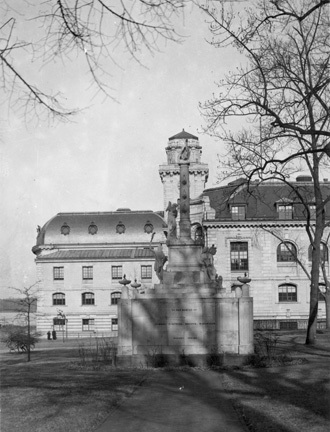 The following is from the January, 1972 issue of Proceedings.
The following is from the January, 1972 issue of Proceedings.
For 112 years, the Tripoli Monument has stood on the grounds of the U. S. Naval Academy in Annapolis, but its unique and tumultuous history began long before 1860. Originally erected at the Washington Navy Yard in 1808, it was the Federal capital’s first monument and for a period of 35 years the only monument in the District of Columbia. It witnessed and weathered the War of 1812; the building, burning, and rebuilding of the Capitol, and the slow establishment of the city itself. For 52 years, its existence was plagued with uncertainties and agitations.
The idea for the memorial rose amidst the rage and ruin of the war against the Barbary Pirates of North Africa, the first formal war under the young nation’s Constitution. Success of the small fleet in Mediterranean waters marked the rebirth of naval power, which had been disbanded after the Revolutionary War, as well as the emergence of the Navy as a permanent force.
A Tripolitan observer of the time was quoted as saying: “The English, French, and Spanish Consuls have told us that they [the Americans] were a young nation, and got their independence by means of France; that they had a small navy and their officers were inexperienced, and they were merely a nation of merchants, and that by taking their ships and men, we should get great ransoms. Instead of this, their Preble pays us a coin of shot, shells, and hard blows; and sent a Decatur, in a dark night with a band of Christian dogs fierce and cruel as the tiger, who killed our brothers and burnt our ships before our eyes.”
Thus, in view of its origin, references to it later simply as the “Navy Monument” seem fitting, although such references became popular largely owing to its having been sponsored, bestowed, and placed by the Navy. “This monument owes its existence,” wrote architect Benjamin H. Latrobe in 1813, “not to publick gratitude in our national government, nor to patriotick feelings of the citizens at large; but to the private friendship & admiration of the officers of the navy, who, of their own accord, assigned a portion of their pay to the erection of a memorial of actions as heroick as any that were ever achieved in naval warfare; from which, although they shared in the glory, their country alone derived the benefit.”
Captain David Porter was in charge of procuring the memorial in honor of six fellow officers who so gallantly sacrified their lives at Tripoli: Somers, Caldwell, Decatur, Wadsworth, Dorsey, and Israel. Aided by the influence of the Bishop of Florence, Porter obtained the services of Micali of Leghorn, famous Italian sculptor, to design and execute the proposed piece for a moderate sum.
The white marble monument consisted of a column 30 feet high, mounted on a pedestal and topped by the American eagle. On two sides of the column were carved three antique beaks of galleys, and on the other two sides, antique anchors in flat relief. At the pedestal were life-size symbolic figures. Inscriptions and urn lamps at each corner of the base completed the altogether pleasing effect.
It was shipped to Newport, R. I., in the uss Constitution, then brought to Washington in the hold of another vessel, where it remained until further subscriptions could be made to defray entry fee and erection expenses. Various applications for assistance from Congress proved fruitless.
When funds finally became available, the problem arose of agreeing on a proper location. The original idea of placing it at the Capitol had to be abandoned owing to the unfinished state of the building, among other objections. A site in the Navy Yard was chosen. According to Latrobe, it was”… the principal object of view to all those who enter the yard, either by land or water, and to an extensive portion of the City and of the port.”
Here it remained in relative peace until the death of Admiral Thomas Tingey, Commandant of the Navy Yard. Soon thereafter, arguments for the Capitol as a site for the monument were revived. In 1831, Congress allocated funds for its relocation.
Admiral Porter was out of the country at the time, and upon his return saw the monument in its new surroundings on the west side of the Capitol. He was disappointed and bitter, as he wrote to a friend:
“And to cap the climax of absurdity, the Naval Monument had, as an evil omen I presume, been placed in a small circular pond of dirty fresh water-not large enough for a duck puddle-to represent the Mediterranean Sea.”
Dissension and dissatisfaction continued until 1860, when the monument was moved to Annapolis. Home at last, but even here it had to be relocated as the Academy developed and expanded.
In its present resting place, between Preble Hallwhich houses the Naval Academy Museum, the Naval Academy Athletic Association, and the U. S. Naval Institute-and Leahy Hall, may the inspiring memorial reign long and peacefully, honoring the “heroes that fell before Tripoli” during that early but very important period of American and naval history.




